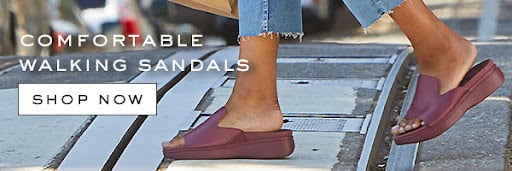
Whether we’re walking around a grocery store or balancing our best Warrior pose in yoga class, we rely on our feet to carry us through everyday life.
Our feet are under a lot of pressure. And, just like our brains, our feet enter protective mode when faced with a lot of pressure. You might wonder, “why do my feet hurt?” For many people, that protective mode results in corns.
What are corns on feet? They’re a thick, protective layer of skin that results from extra friction or pressure. For answers to this question and more, you’ve trekked to the right place—so kick up your feet and read on.
How Corns are Formed
Repeated friction and pressure are a recipe for the thick skin that ends up as corns. It may seem counterintuitive, but your skin is trying to do you a favor when it creates corns. It thickens to protect you from injuries like blisters, bruises, and cuts.1
In many cases, corns form from shoes that don’t fit well. Corns like these develop because your toes rub against each other or your shoe.2
Two different kinds of corns can develop:3
- Soft corns – These corns form between the toes. They are white or gray in color and have a texture similar to rubber.
- Hard corns – These corns form on the top of the toes, where bone presses against the skin. They are typically smaller and denser.
Corns aren’t something that a doctor needs to test for. No x-rays or other fancy machines required. Instead, they can be visually identified.
Signs that you have corns include skin that is:1
- Bleeding
- Dry
- Flaky
- Hardened
- Painful
- Thick
It’s rare for corns to cause complications outside of general discomfort. However, if an ulcer or infection occurs in the area, medical treatment may be required. People with diabetes are more likely to experience these complications.1
Corns vs. Calluses
We’re about to illuminate this alliterative nightmare. You may hear corns and calluses used interchangeably as you venture out into the world in search of foot-healing solutions.
Indeed, they share more in common than the first letter of their names. They both describe a thick area of skin. The difference lies in their location on the body.
You’ll find corns on the top or side of your toes. On the other hand (or foot), calluses form on the soles of your feet. Calluses can also form on your hands, and they are generally larger than corns.1,3
What Causes Corns on Feet
Understanding the causes of corns is your first step toward treatment and prevention. We’ve already covered the role that friction and pressure play in their development. There are also specific foot problems and habits that can make you more likely to develop them.
Foot problems that affect the alignment of your foot can predispose you to develop corns.
Specifically, ailments such as:
- Bone spurs – When your joints are damaged, new bone material can grow and create lumps that cause foot pain and affect your movement.4 This change to the alignment of your feet can make it more likely for your feet to develop corns.3
- Bunions – Both the base of the little toe and the big toe can experience bunions from repeated pressure on the joint, causing it to protrude. Bunions are common in those with arthritis or people who wear shoes that are too tight.2 Since bunions stick out, they experience more of that extra pressure that causes corns.1
- Hammertoes – The second toe usually experiences this foot problem, but it can happen to the other toes, too. The toe becomes deformed, and its middle joint sticks out.2 A foot corn can develop where shoes rub against this protruding joint.1
Certain lifestyle habits can also make you more likely to develop them, including:3
- Walking with bad posture
- Walking barefoot outdoors
- Wearing shoes that are narrow or too-tight
- Wearing high heel shoes
- Smoking cigarettes
- Not wearing socks or wearing socks that slip
When you think about treatment and prevention, start by identifying if you have any of these conditions or habits that predispose you to develop corns on your feet.
Four Simple Steps to Treat Foot Corns
Foot corns are common and treatable with the right strategy. So if you’re experiencing corns on your feet, there’s no need to worry. The best treatment option is both simple and inexpensive.
In fact, treatment is as easy as these 4 steps:5
- Soak
- Exfoliate
- Moisturize
- Pad
Step #1: Soak Your Feet
Great news: step one is a soothing spa experience. You’ll want to soak your feet in warm water for 5 to 10 minutes. This helps soften that tougher skin.5 While you wait, you can put on a face mask or your favorite playlist and relax.
When you soak your feet, you will want to avoid hot water because it can cause dry skin.7 Some people choose to add ingredients to their foot bath such as:8
- Epsom salts
- Honey
- Oatmeal
- Peppermint oil
- Vinegar
Step #2: Exfoliate Your Feet
After the warm water has softened your feet, you can file down the corn or rougher skin. This is a step where you want to be extra careful. Removing too much skin can cause bleeding or an infection.
There are two types of exfoliants you can use safely on your feet, including:6
- Chemical Exfoliants – These are acids like alpha-hydroxy acid (AHA), glycolic acid, and lactic acid that break apart dead skin cells on a molecular level.
- Physical Exfoliants – These are products that manually remove skin cells. Think foot brushes, foot scrubs, body brushes, and pumice stones.
While there are a wide variety of exfoliants on the market and in the beauty aisle, the American Academy of Dermatology Association recommends using a pumice stone. Rinse the stone with water and then move it in circular or sideways motions to break up and soften tough skin caused by foot corns.5
Step #3: Moisturize Your Feet
Once you’ve finished exfoliating the skin (and remember not to exfoliate too much), you can move on to moisturizer. This helps to infuse hydration into new skin cells.
Of course, there is no shortage of foot creams on the market. To narrow your search, the American Academy of Dermatology Association suggests finding one with any of these three ingredients:5
- Ammonium lactate – This is an over-the-counter moisturizer that treats dry, itchy, and scaly skin, which is the perfect remedy for corns on feet.8
- Salicylic acid – This is a popular chemical exfoliant in skincare that doubles as a moisturizer or can be found in moisturizing products.9
- Urea – This ingredient also works as both a moisturizer and a chemical exfoliant. You’ll find it in many moisturizing products at the store10
Adding a foot cream to your daily self-care schedule will help treat any corns you do have and prevent more from forming in the future.
Step #4: Pad Your Feet
Last but not least, you’ll want to prevent your foot corn from becoming irritated by padding them to protect the skin you’ve just cleaned and moisturized.
You can use moleskin from the drugstore and cut it into two-half moons, placing each on one side of the foot corn to protect the area. You can also use adhesive bandages to surround the area—but be careful not to wrap it too tightly.5
Ways to Prevent Corns on Feet
Treating corns isn’t difficult, but preventing them in the first place lends a sigh of relief. So, how can you safely remove the thick dead skin from your feet? The goal is to stop the friction and pressure that causes both corns and calluses to form in the first place.1
With that in mind, prevention strategies fall into these 2 memorable, rhyme-affirming categories:4
- Footwear
- Foot care
Choose Proper Footwear
Corn prevention starts with proper footwear. Choose shoes and socks that fit your feet comfortably without rubbing against certain areas while you walk:
Consider these factors as you choose your footwear:4
- Socks – Always wear socks and make sure that they fit well. They shouldn’t bunch or slip. This helps prevent a significant amount of friction.
- Shoes – A good-fitting pair of shoes have adequate space, both length and width, for your toes. If you’re going to wear high heels or leather soles, make sure you use insoles or choose pairs with added support to reduce friction and pressure.
- Insoles – Cushions like lamb’s wool or insoles can redistribute your body weight on your feet so that you don’t develop corns, calluses, or other foot problems.
Prioritize Foot Care
Once you take your shoes off, there are several foot-care habits you can use to prevent corns from forming on your feet.
Work these foot-care habits into your daily routine:3
- Keeping your feet clean
- Moisturizing your feet
- Using foot powder on sweaty feet
- Trimming your toenails regularly
The dynamic duo of proper footwear and foot care can go a long way to keep your feet happy, healthy, and corn-free.
Vionic: Shoes that Care about Foot Care
Don’t let corns on your feet steal your barefoot confidence or comfort as you traverse the exciting terrain of life. Foot corns are easy to prevent by soaking, exfoliating, moisturizing, and padding your feet—along with wearing proper footwear and taking proper care of your feet.
At Vionic, we’ve set out to develop footwear that does both. We take foot care seriously. So if you’re looking for shoes and insoles to protect your feet and make you look and feel your best, turn to Vionic.
Explore our wide range of stylish, comfortable shoes for every occasion and kick corns to the curb.
Sources:
- “Corns and calluses.” Mount Sinai. https://www.mountsinai.org/health-library/diseases-conditions/corns-and-calluses
- “Foot Pain and Problems.” Johns Hopkins Medicine. https://www.hopkinsmedicine.org/health/conditions-and-diseases/foot-pain-and-problems
- “Corns and Calluses.” Cleveland Clinic. https://my.clevelandclinic.org/health/diseases/16896-corns-and-calluses
- “Bone Spurs (Osteophytes).” Cleveland Clinic. https://my.clevelandclinic.org/health/diseases/10395-bone-spurs-osteophytes
- “How to Treat Corns and Calluses.” American Academy of Dermatology Association. https://www.aad.org/public/everyday-care/injured-skin/burns/treat-corns-calluses
- Eske, Jamie. “Best remedies for dry skin on the feet.” Medical News Today. Updated 14 April, 2023. https://www.medicalnewstoday.com/articles/324909
- Chertoff, Jane. “7 Ways to Remove Dead Skin from Your Feet.” Healthline. Updated 21 March, 2023. https://www.healthline.com/health/how-to-remove-dead-skin-from-feet
- “Ammonium Lactate 5 % Lotion – Uses, Side Effects, and More.” WebMD. https://www.webmd.com/drugs/2/drug-339-164/ammonium-lactate-topical/emollients-topical/details
- Morrill, Hannah. “The Unsexy Foot Cream Dermatologists Swear By.” New York Magazine. 25 May, 2017. https://nymag.com/strategist/article/best-dermatologist-foot-cream-review.html
- Yetman, Daniel. “What Purpose Does Urea Serve in Skin Care Products?” Healthline. 18 January, 2021.https://www.healthline.com/health/beauty-skin-care/urea-in-lotion


Leave a Reply